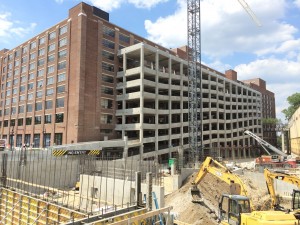
Ponce de Leon Park 1948 | AJCP142-022q, Atlanta Journal-Constitution Photographic Archive. Special Collections and Archives, Georgia State University Library
Ponce City Market and its surrounding communities have been influenced by political factors. With the association between political leaders, urban planners, and residents, endeavors have been conducted to revitalize the city of Atlanta. This democratic process has its benefits in redeveloping obsolete properties for renewed use, though disadvantages also occur that perpetuate the isolation of particular groups. The intensity of gentrification is predominantly noted within Ponce City Market and the Beltline’s impact on surrounding neighborhoods. By removing insufficient, worn-down housing and displacing the respective residents, developers were able to construct much of the Beltline which is conjoined to Ponce City Market. In turn, an influx of middle to upper class citizens relocated to the newly developed sites and caused immense displacement of lower class families. This process of renovation perpetuates cultural, social, and economic distinctions while continuing a lack of integration between different groups. When vastly different demographics are not intermixing, polarization and intolerance ensues. Additionally, with this revitalization throughout Ponce de Leon, housing prices have dramatically increased. Ryan Gravel, the creator of the Atlanta Beltline, envisioned the communities around the Beltline to exhibit equal opportunities for housing. Therefore, residences of all prices which would include all socioeconomic classes would reside along its path. Unfortunately, this ideal has not remained true with new construction. An overwhelming majority of housing around the Beltline is designated for middle to upper class civilians which excludes lower income groups. From this disparity, many Atlantans have voiced their discontent including Gravel himself. Ultimately, the goals that attempted to result in equality have done the opposite to Atlanta residents.
It must also be regarded that Ponce City Market excludes particular groups which may or may not have been intentional in its foundation. With its expensive prices in every aspect (retail, food, parking, etc.), the market targets individuals with a larger expendable income. Therefore, lower class families are unable to spend copious amounts of money because such purchases take up a greater portion of their income than a middle to upper class family. With this notion, lower classes are subliminally excluded from participating in such transactions due to the progressive prices that are exhibited throughout the market. Another current debate exists within Ponce City Market’s parameters. The revitalization of Atlanta’s old railway system has become proposed for the Atlanta Beltline Incorporation. This public transportation would extend to the Beltline’s 22-mile trail system and allow immediate access to 45 different neighborhoods within Atlanta. As a result, these encompassing communities would have a direct connection through the Beltline’s transport. This project acts as a response to Atlantan’s dissatisfaction of current public transportation and the increasing demand of the Beltline’s use. However, many debate the extent of the railway system since its parameters are bounded within the city of Atlanta. Should the routes extend to metro-Atlanta and suburban areas so the transportation can include a larger group? For many citizens, urban planners, and politicians, the implications are too dense if the expansion occurred. Homelessness would increase within suburbs and exponentially more funding would be required to fulfill such actions. On the other hand, because of this confinement, the transportation can only be accessed by a limited group of local Atlantans. Therefore, the railway’s success is restricted.

Construction on Ponce de Leon 1988 | AJCP233-050v, Atlanta Journal-Constitution Photographic Archives. Special Collections and Archives, Georgia State University Library
